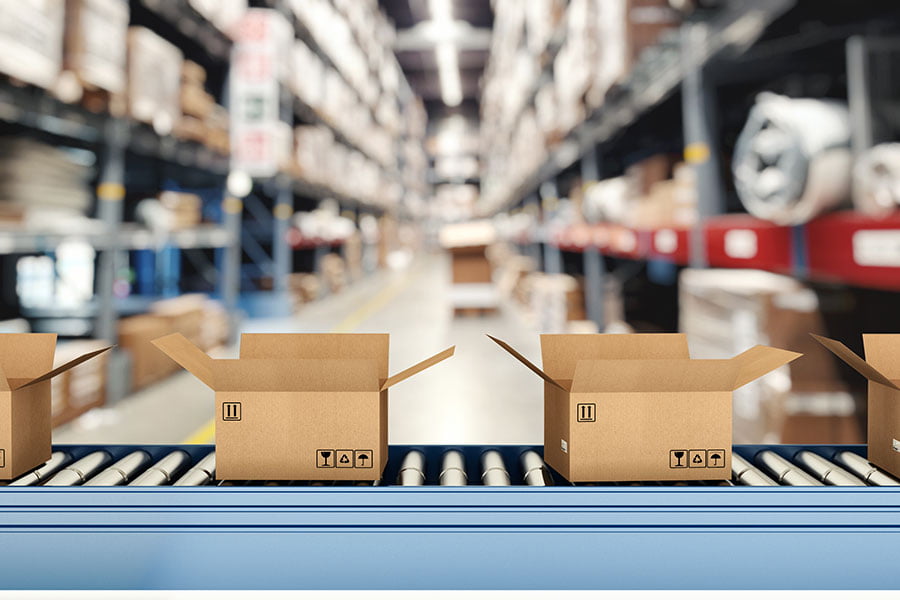Published October 18, 2017
Tompkins International has been leading the way with our point of view that retail is at a crossroads, over the past five years.We first discussed retail at a crossroads, in the white paper, Retail at a Crossroads Future Hangs in the Balance as Retail Industry Passes Tipping Points, in 2012. The paper continues to make waves.
This material has received attention from retailers and media alike, but the extent of the changes required by companies and brands are not truly evident to most company leaders. In fact, to this day many retailers and brands continue to argue that a crossroads does not exist and that no action is required to save their companies from financial ruin.
The concept of retail at a crossroads is simple; change what you are doing to a counter-offensive posture or risk the consequences of failure.
The crossroads is different for each company and each brand, but represents the point at which a company makes choices and selects alternatives to transform or reinvent their supply chains, Unichannel (Unified Channel) practices, and customer relationships.Companies who are grasping this reality are moving aggressively toward solutions which give them a fighting chance in the marketplace.
The current state of retail has gone beyond the crossroads into unchartered territory. This unchartered territory is being dominated by Amazon, and only a few companies are having success competing with their processes, technology, and infrastructure.
You must know who your competition is and determine how to best form a counter-offensive to match Amazon and others who intend to take your customers, sales, and future success.
Some companies have decided to partner with Amazon thinking this is the path to success. Most have found this instead is a challenge at best and a game ender at worst.For a host of reasons, one being Amazon has a single-minded approach to win the hearts and minds of consumers without regard for companies selling through them.
Companies need to be aware of the current events that are shaping the marketplace and customer’s expectations, in the race for their dollars and loyalty.There have been remarkable changes in the U.S. retail market over the last few years and even months, generally lead by Amazon, although Wal-Mart has been pushed to create new approaches to consumers and expectations as well.Amazon and Wal-Mart have brought to the market numerous innovations, pursued acquisitions that influenced market dynamics, and brought online supply chain infrastructure (facilities, practices, and technology) at an unprecedented rate.These changes have opened a huge gap in supply chain performance between the giants of eCommerce/Unichannel and everyone else, particularly with respect to speed of delivery.
They can no longer be classified merely as disruptors, due to the massive changes they have forced on the retail market. “98% of retail executives recognize the changing customer behaviors and other forces are disrupting their industry, but only a minority are taking action to address the changes.” Of these companies 31% are repositioning their business model, 40% optimizing current operations, and 24% turning around short-term issues.
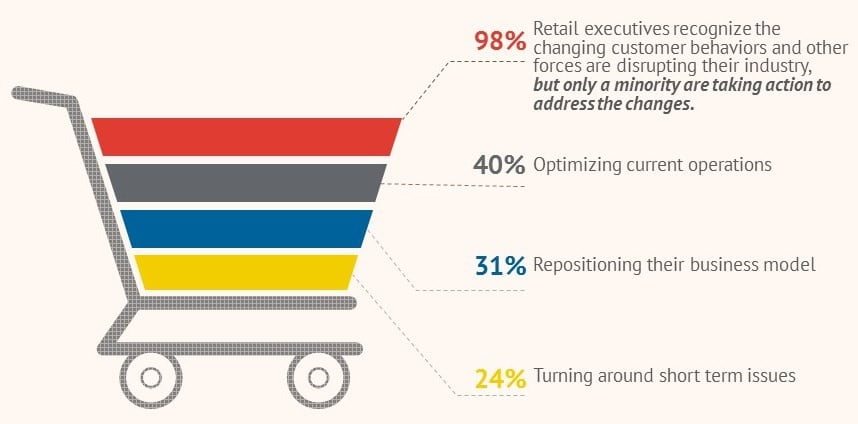
Supply chain leaders concerns and worries include store closings and bankruptcies. Today we are accustomed to daily announcements of store closings, involving companies we had long thought to be retail leaders. We are now in the third wave of store closings since eCommerce gained significant volume. Companies such as the following, are closing stores at an alarming rate to right-size their store footprint:
- Sears
- K-Mart
- Macy’s
Some of the store closings are the result of overbuilt retail networks in the U.S., but many can be tied to a lack of an eCommerce presence.In some cases, rapidly declining store sales.Bankruptcies are also a much more common occurrence these days than in the past as companies are impacted so greatly by lost customers that they face bankruptcy.Companies such as the following, are bankrupt.
- Toys ‘R’ Us
- Gymboree
- Office Depot
- Staples
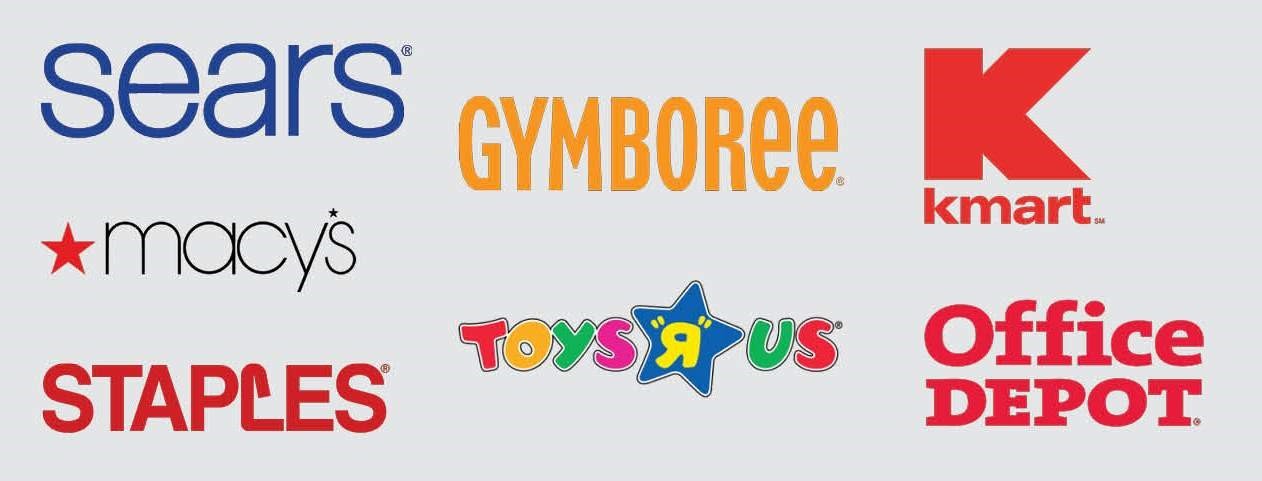
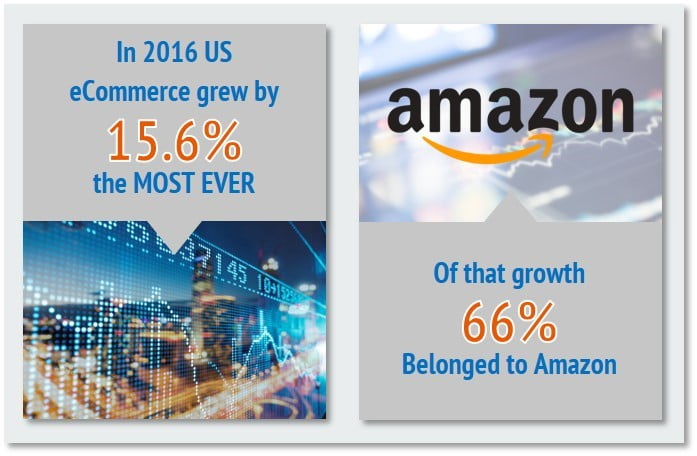 Last year, U.S. eCommerce grew by 15.6%. This is the most growth ever recorded in eCommerce in the U.S. The bad news for competitors of Amazon is that 66% of last year’s growth belonged to Amazon. The longer term does not seem to point to a change in this dominance by Amazon in the eCommerce world, as consumers now equate online shopping with Amazon and they continue to provide strong reasons for this preference. Another significant fact is that only 10% of companies in the eCommerce market are profitable.
Last year, U.S. eCommerce grew by 15.6%. This is the most growth ever recorded in eCommerce in the U.S. The bad news for competitors of Amazon is that 66% of last year’s growth belonged to Amazon. The longer term does not seem to point to a change in this dominance by Amazon in the eCommerce world, as consumers now equate online shopping with Amazon and they continue to provide strong reasons for this preference. Another significant fact is that only 10% of companies in the eCommerce market are profitable.
Fulfilling eCommerce orders is not just about the capability to ship, it is also about efficiency and costs. Companies can ship products, but doing so profitably is proving to be very difficult. When it comes to fulfillment of eCommerce orders Amazon leads all other retailers and brands. The number of facilities that they have and the volume of units they can ship are unmatched and continues to grow over time. Amazon has over 70 fulfillment centers throughout the U.S., with most markets receiving same day or next day delivery of products.
Their fulfillment is supported by leading edge technology that also puts them ahead of their competition with the capability to operate efficiently in today’s Unichannel environment. Innovations such as Prime Now are also putting extreme pressure on competitors to match the delivery capabilities of Amazon. Consumers have realized that getting a delivery of an eCommerce order in as little as a few hours, is possible. Amazon is often, the only game in town with this kind of service capability.
The potential for goods to be sold and shipped across country borders (crossborder) has opened huge opportunities for those companies who can meet the needs of consumers in other geographic regions.The desire for consumers in Asia and Europe for American made goods has increased substantially; filling this need has become a significant sales growth opportunity.Companies who have recognized and embraced this opportunity have benefited greatly.
The key players in crossborder trade and transportation are:
- Alibaba – China
- Amazon – U.S, U.K., and Germany
- JD.com – China
- eBay – U.S., Europe, and Asia
- Rocket – Southeast Asia
- Mercadolibre – South America
- Rakutan – Japan
- Flipkart – India
The goal is to have the ability to sell from anywhere to anywhere with two to four day shipping.
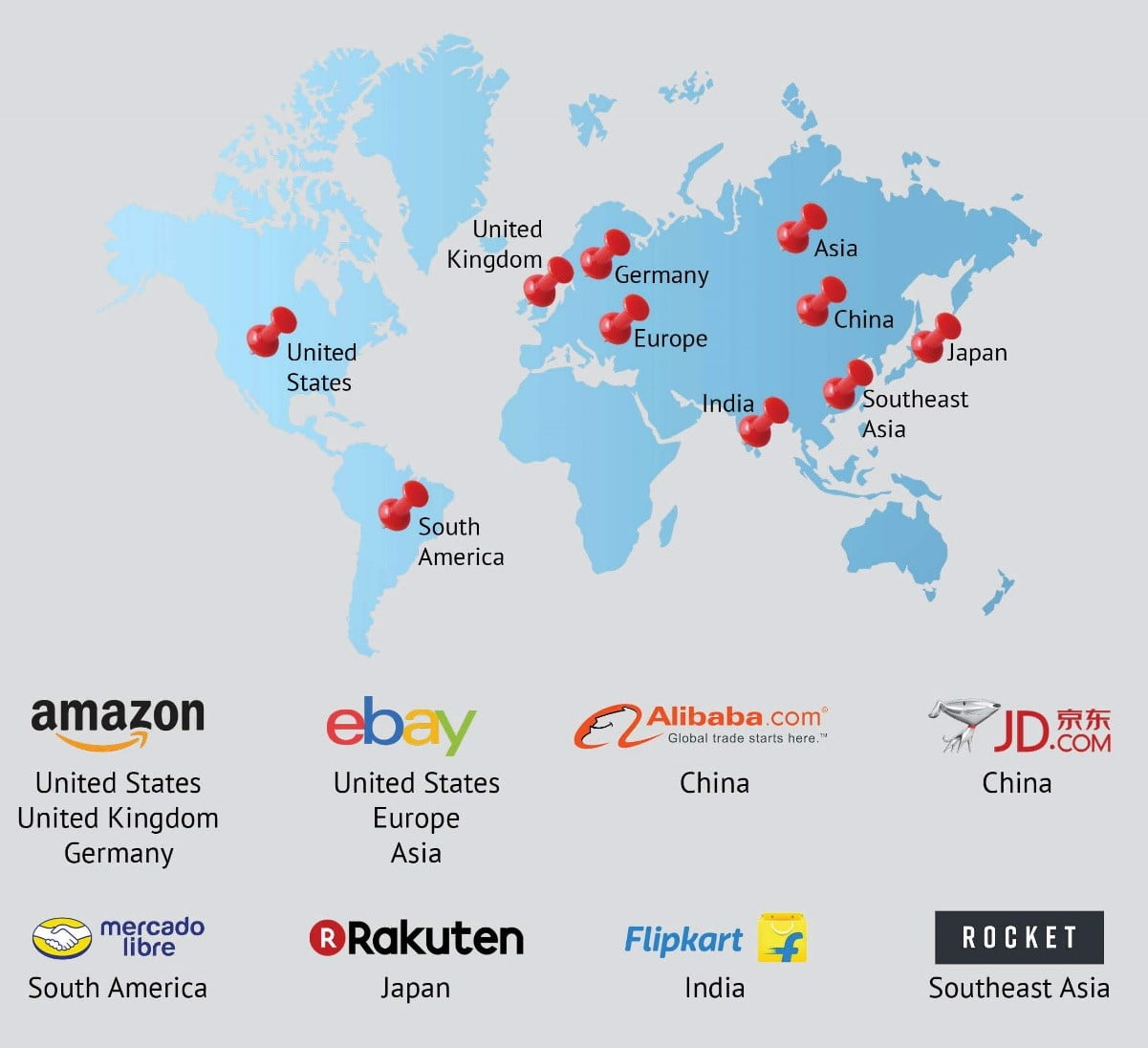
Many of the companies who are successful with online sales have a digital strategy in place and infrastructure to support eCommerce physical operations.Without a digital strategy to support, from all customer perspectives, leads to a loss of sales and a diminished customer base.
Online sales and online success are two different things.As mentioned earlier only 10% of companies in the eCommerce market are profitable.What are the 90% doing to impact their costs so that they are losing money?

Chasing sales without efficient distribution and transportation options and without regard for profitability, equals loss.Not understanding their true cost of doing business so poor pricing practices, equals loss.Trying to be like Amazon and other major eCommerce players without the correct capabilities, equals loss.
To stay on top of the significant developments in supply chain affecting eCommerce is nearly impossible.Supply chain professionals are experiencing a change overload and as a result are less effective than needed to meet the challenges of the day.Strategies are not being fully developed, priorities are not always clear, and supply chain leaders cannot keep up the pace. In some organizations’ senior executives and board members are searching for answers to “right the ship”, but competitive forces are intense.It is no longer good enough to be a medium to large retailer with great stores and practices for customer service, as eCommerce drives not only online sales, but also significant in store sales.
Companies like Amazon are not content to fill online orders with brands products.They are becoming the world leader in private label products from apparel to grocery to household goods.They are using the information they collect to learn what is trending and then move to leverage that information for private label products in industry after industry.

It is important to understand the blending of Bricks and Cliques as a technology opportunity. Amazon with the purchase of Whole Foods has brought technology to life in the store. Amazon wants to make store shopping more like online shopping. We read about deploying cameras and infrared sensors to monitor foot traffic, using data algorithms to do real time cashier scheduling, mobile apps that analyze shopping habits and produce relevant digital coupons, sensor-laden interactive shelves that detect shoppers in the aisles via the phone to offer deals and suggest products, creating customer “favorite lists” apps, cashier-less stores, digital shelf edges, etc. This is the coming together of Bricks and Cliques.
Post-Clique, after the customer places their order, delivery is extremely important to all eCommerce companies. For food retailers it is either the critical element, extremely important, or unimportant. Post-Clique logistics is the critical element when a customer is ordering fresh (Fresh) and the customer lives in a major urban center (Big City). Post-Clique logistics is extremely important when we are restocking the pantry (Pantry Restock), it is unimportant when the customer orders fresh and lives in small urban or rural area (Non-Big City) or for unique pantry (Unique Pantry).
Clearly the U.S. leader in non-food eCommerce Post-Clique logistics collaboration is Amazon. Amazon has done an awesome job of free Post-Clique logistics fulfillment and delivery. Amazon has altered customers’ expectations with respect to how quickly they expect to receive orders.
It is clear no retailer themselves can compete with the Amazon Post-Clique logistics ecosystem. Therefore, what is needed is a collaboration of retailers, brands and marketplaces working together as one. A collaboration model has been developed and is rolling out these capabilities for Holiday 2018. This model is The MonarchFx Alliance.
MonarchFx is the only Post-Clique collaborative firm that has superior fulfillment center design experience, proprietary material handling systems capability, superior information technology systems, demonstrated excellence in fulfillment center operations and best-in-class final delivery transportation. From a cost and service perspective the eCommerce logistics market will be dominated by Amazon and MonarchFx. Amazon will continue to be successful, but MonarchFx will gain market share and allow retailers, brands and marketplaces to play on a level logistics playing field while they focus their attention on the Pre-Click competition with Amazon. We see the bold, aggressive, innovative and quick retailers, brand and marketplaces partnering with MonarchFx and taking market share from Amazon. This will occur as they will be able to have focus on their customer experience, their product selection and their value proposition while leaving the logistics to MonarchFx.
The MonarchFx Alliance is the only Post-Clique logistics ecosystem that will work in conjunction with an already in place retailer’s Post-Clique logistics network, offering the speed of delivery of Amazon at operating and capital cost significantly less than the cost of doing one’s own post clique logistics.
Customers today require that the retailer knows who they are.They recognize the larger market at play and market their products to their intended customer. They think global in marketing and differentiate themselves from the field by the uniqueness of their products and the customization they provide.
At the end of the day, when the customer is happy the retailer benefits both in terms of increased customer retention and margin. Therefore, the key to supply chain and company success lies in telling the customer the price of the different options and then let the customer tell you how to make them happy and your company more profitable.
This is the beginning of the era of new retail, retail innovation, a new shopping experience, game-changing Demand-Driven Replenishment and an Each Supply Chain. This new era will place the customer in charge of the Unichannel to enjoy the exploration and experience of shopping while maximizing convenience, value and selection. This new era of retail will drive retailers’ success and profitability.
About Tompkins International:
A supply chain consulting and implementation firm that maximizes supply chain performance and value creation. We enable clients to be more profitable and valuable, while also becoming more agile, flexible, and adaptive to the marketplace. Tompkins collaborates with client teams to develop improved operations strategies, supply chain planning, and execution across all the Mega Processes of supply chains (PLAN-BUY-MAKE-MOVE-DISTRIBUTE-SELL). Tompkins is headquartered in Raleigh, NC and has offices throughout North America and in Europe and Asia. For more information, visit: www.tompkinsinc.com.
About MonarchFx
The MonarchFx Alliance is the coming together of world class supply chain and logistics companies with world class sellers of products to form a reinvented logistics ecosystem that is new, smart, and innovative. The Alliance offers a local automated fulfillment network and local/regional final delivery services at a competitive price, providing great customer service. The vision of MonarchFx is to be the preferred direct-to-consumer logistics provider, operating with the lowest cost, while delivering the highest levels of customer service, and providing superior value for MonarchFx sellers. The mission of MonarchFx is to create, build, and manage a substantial logistics ecosystem that establishes MonarchFx Alliance members to become the preferred direct-to-consumer logistics solution in the United States. For more information visit: www.monarchfxalliance.com.

